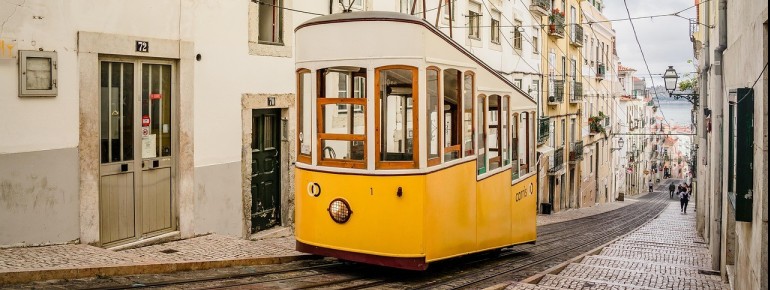Contents
Description
Lisbon's funicular railways are technical masterpieces of the 19th century that continue to shape the city's landscape to this day. A total of three historic railways – Ascensor da Glória, Ascensor da Bica and Ascensor do Lavra – connect the steeply sloping areas of the old town. These railways were created out of practical necessity: the early horse-drawn tram could not cope with Lisbon's extreme gradients, which is why funicular railways were introduced in 1884. Originally powered by water ballast, all three funicular railways were electrified between 1910 and 1915. Today, they are much more than just a means of transport – they are considered national technical monuments and offer an authentic travel experience for every visitor to Lisbon.
Ascensor do Lavra – The oldest and steepest funicular railway
The Ascensor do Lavra is Lisbon's oldest funicular railway and has been in operation since 1884. It climbs 43 metres over a distance of 182 metres with an impressive maximum gradient of 25 per cent, making it not only the steepest of the three railways, but also one of the steepest funicular railways in the world. It connects Rua São José with the quiet neighbourhood of Pena and the charming Jardim do Torel viewpoint. As this railway is rarely used by tourists, it offers a much more relaxed ride and is ideal for authentic photographs without crowds.
Ascensor da Glória – The most famous and most used railway
The Ascensor da Glória has been in operation since 1885 and is the best known and most frequented of Lisbon's three funicular railways. It climbs 265 metres and 48 metres in altitude at an average gradient of 17 per cent. The characteristic yellow carriages with wooden seats and brass details, manufactured in Germany, connect the central Praça dos Restauradores with the popular Bairro Alto district and the beautiful Miradouro de São Pedro de Alcântara viewpoint. Every year, the two nostalgic cabins carry over three million passengers up the steep route.
Ascensor da Bica – The most scenic funicular railway
The Ascensor da Bica is the youngest of the three funicular railways and was opened in 1892. It connects the Cais do Sodré district with the upper town, covering a distance of 260 metres with a height difference of 45 metres. With an average gradient of 11 per cent, it is the gentlest of the three funicular railways, but also the most popular with tourists. Its picturesque location and spectacular view of the Tagus estuary make it the most popular choice, but this also means longer queues – especially at the upper station near Bairro Alto.
Historical Information
The funicular railways were created as a solution to one of Lisbon's main problems: its hilly terrain. Portuguese engineer Raoul Mesnier du Ponsard designed the railways based on the successful Elevador do Bom Jesus in Braga. All three were initially powered by water ballast – a system in which the carriages were kept in balance by water counterweights. In 1886, they switched to steam power, before electrification between 1910 and 1915 brought about their final modernisation. Since 2002, the three historic facilities have been listed as historic monuments. Today, they are operated by the municipal transport company Carris – just like the city's trams.
How to get there
By car
Parking is available in the immediate vicinity of all three valley stations. At Ascensor da Glória, there are parking spaces around Praça dos Restauradores. Ascensor da Bica can be reached via Rua de São Paulo, with parking available in the surrounding streets. Ascensor do Lavra has parking spaces on Rua São José and in the adjacent areas.
By public transport
The valley stations of the three funiculars are located in central and easily accessible locations. The Ascensor da Glória starts at Praça dos Restauradores, where the metro station of the same name is located directly below – from there it is only a few steps to the valley station. The Ascensor da Bica has its lower station on Rua de São Paulo in the Cais do Sodré district, accessible by underground to Cais do Sodré. The Ascensor do Lavra is located on Rua São José, about a 10-minute walk from Rossio or by underground to Restauradores, from where it is also accessible.




